Wilkau-Hasslau Branch, Zwickau District
Roger P. Minert, In Harm’s Way: East German Latter-day Saints in World War II (Provo, UT: Religious Studies Center, Brigham Young University, 2009), 497-501.
Situated on a steep hill above the Zwickauer Mulde River, the town of Wilkau-Hasslau is slightly more than one mile east of Planitz. In this small town, The Church of Jesus Christ of Latter-day Saints consisted for all practical purposes of the Damm family at Eichleite 4 and several older ladies. Friedrich Damm was the branch president during the war.
| Wilkau-Hasslau Branch[1] | 1939 |
| Elders | 1 |
| Priests | 0 |
| Teachers | 1 |
| Deacons | 1 |
| Other Adult Males | 6 |
| Adult Females | 25 |
| Male Children | 1 |
| Female Children | 1 |
| Total | 35 |
With nine children, the family of Friedrich and Rose Damm was the core of the small branch, and the meetings were held in their home for several years. With adult women constituting 72 percent of the branch membership, this branch would have benefited from more priesthood holders. As of this writing, three of the nine Damm children were the only persons available as eyewitnesses to the life of the branch in Wilkau-Hasslau and the experiences of its members.
Jutta Damm (born 1933) was the youngest child. According to her memory, the branch meetings held in her home took place in various rooms. Sacrament meeting was held in the main room upstairs. A bedroom was used for an additional Sunday School class, and the children met in the kitchen downstairs for their instruction. Sunday School took place in the morning and sacrament meeting in the evening. On the first Sunday of the month, only a morning meeting was held. According to Jutta, there might have been fifteen persons in attendance on a typical Sunday.[2]
Because there were so few men in this branch, district leaders and other visitors from nearby Zwickau often attended church in the Damm home, including District President Walter Fassmann and his predecessor Bernhard Unger. Music was provided by a small pump organ. “We had some old hymn books and the scriptures,” explained Jutta Damm.
Fred Damm (born 1929), the seventh of the nine children, described the family home during the war years:
It was three stories in all (basement, main floor, and upstairs). We had running water and electricity as well as an indoor WC [toilet]. There was no telephone. We had only one heater—in the kitchen on the main floor; we heated with coal and wood.[3]
The neighbors all knew about the Damms’ membership in the Church. Those neighbors were Lutherans and did not bother attending their own church services except on religious holidays. Nobody seemed to care much about the religious services held in the Damm home, but Jutta recalled that her baptism in 1942 was conducted quietly. After the public indoor swimming pool had closed for the night, the members of the branch were allowed to enter and to use the facility for a baptismal service.
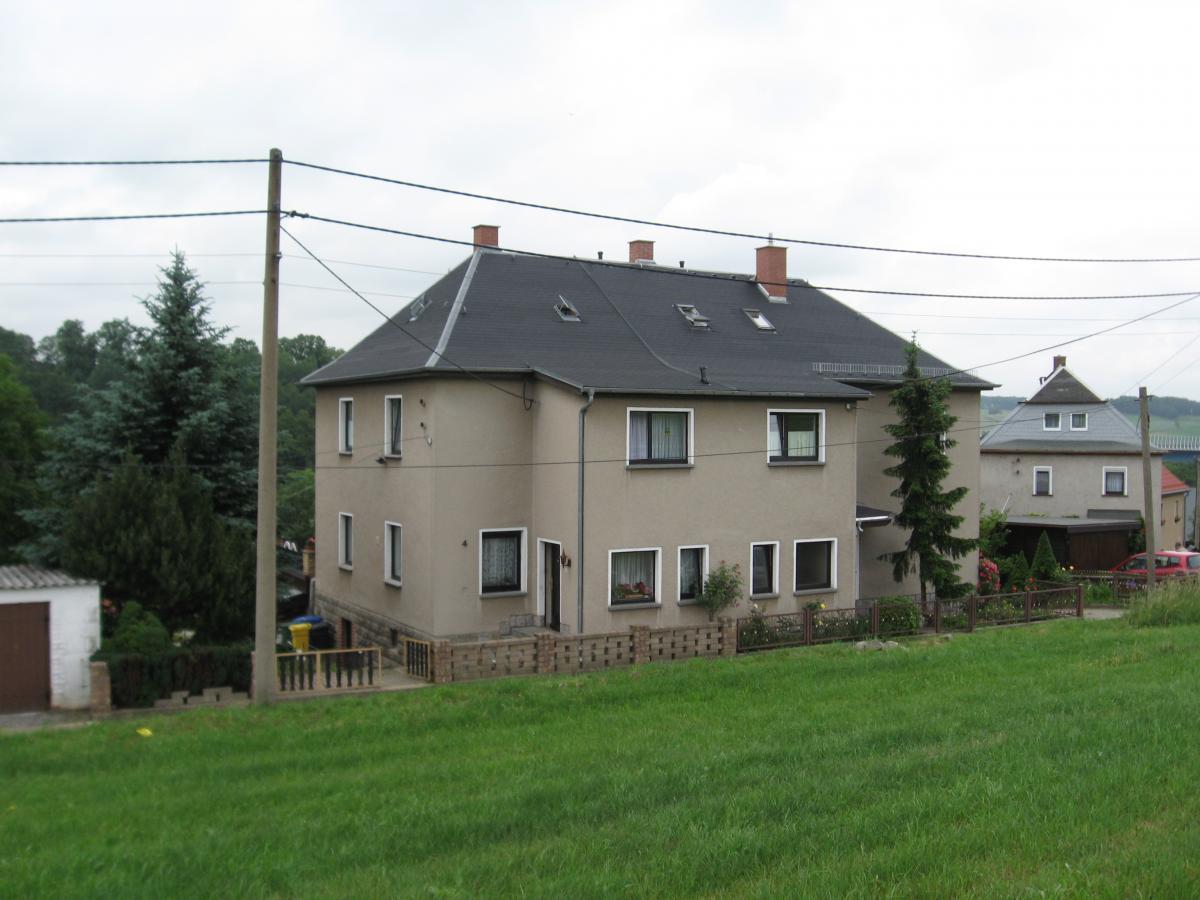 The Damm home at Eichleite 4 as it appeared in 2007 (J. Larsen)
The Damm home at Eichleite 4 as it appeared in 2007 (J. Larsen)
Manfred Damm (born 1931) recalled that an official government visitor would come by now and then during the war to listen to the meetings and the lessons. No interruptions ensued.
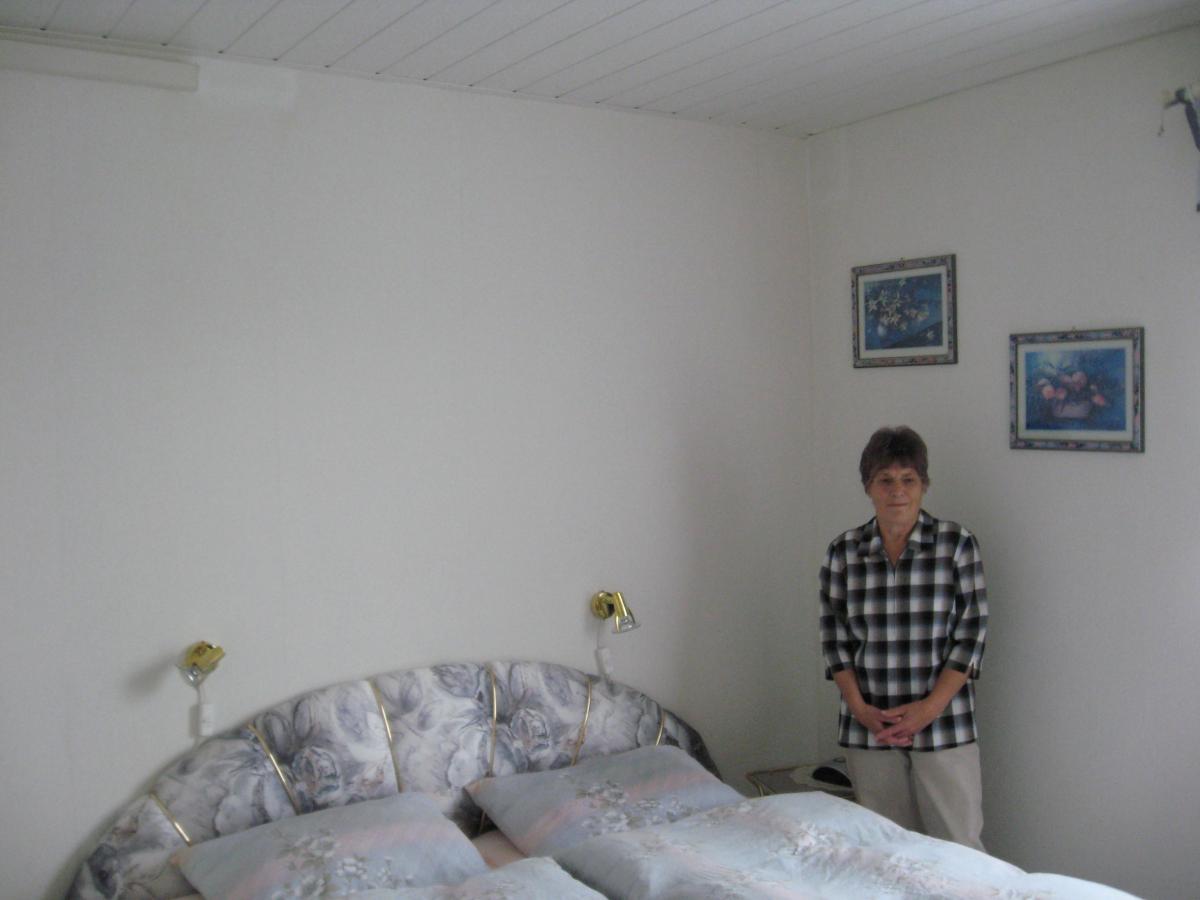 Jutta Damm Sedlacek stands in what was the main meeting room for the Wilkau-Hasslau Branch during the war. She is now the homeowner and uses the room as a bedroom. (J. Larsen 2007)
Jutta Damm Sedlacek stands in what was the main meeting room for the Wilkau-Hasslau Branch during the war. She is now the homeowner and uses the room as a bedroom. (J. Larsen 2007)
When Manfred turned ten, he and his classmates were inducted into the Jungvolk. He later described some of the activities:
We had meetings after school with songs and stuff. Hitler was trying to promise so much for the young people. . . . We had the same organization as the military. . . . On a Saturday, we walked through the streets. We had learned special songs, and every group had a different flag with their number.[4]
As of January 1943, the mission directory showed a different address for the Church meetings: Friedhofstrasse 4. Jutta later described this facility in these words:
It was an impossible building to meet in, [but] we tried to make it look better on the inside. Because the rooms were located inside a large rock, there were steep stairs that all of the children had to climb up to hold Sunday School (there was no Primary meeting at the time).
Fred Damm later explained that in order to attend district conferences in Zwickau, the family first had to walk about twenty minutes to the nearest streetcar station, then ride to downtown Zwickau, then finally walk about ten minutes again. The entire trip might have taken an hour.
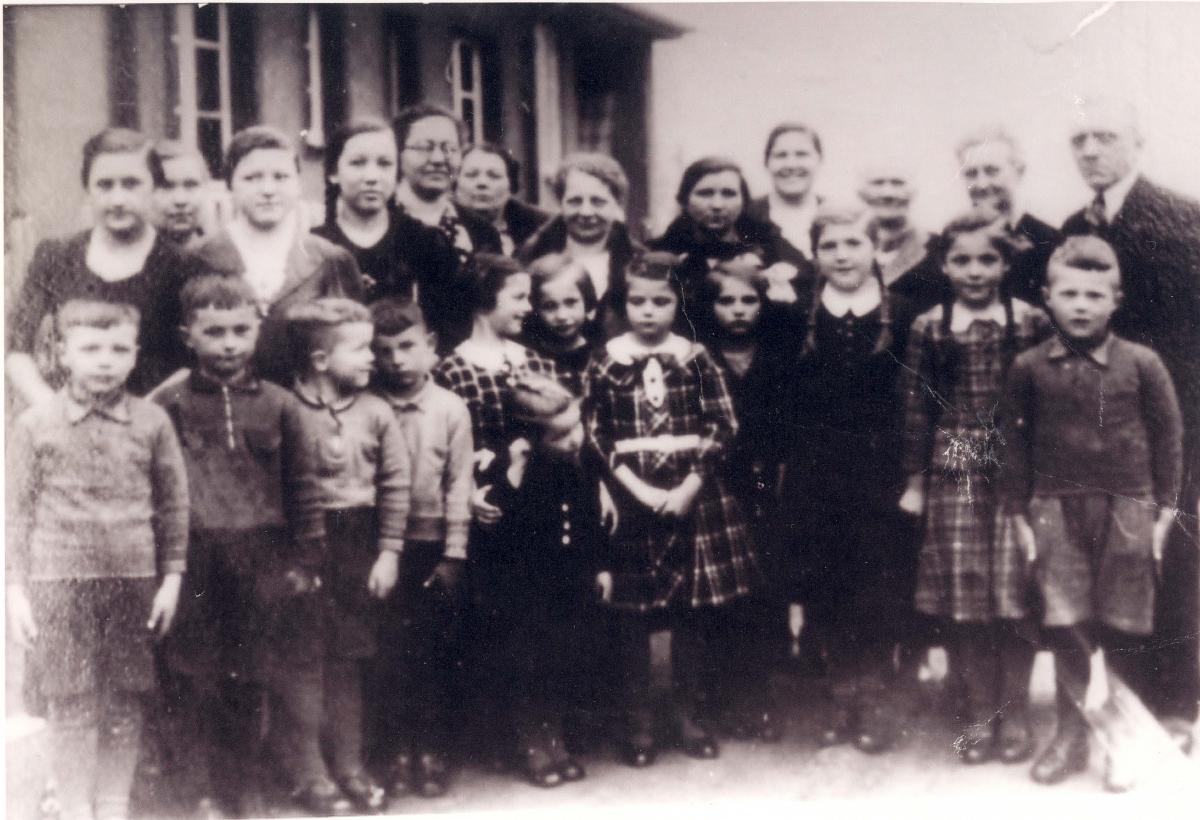 Members of the Wilkau-Hasslau Branch and friends gathered for this photograph in front of the Damm home in 1939. (J. Damm Sedlacek)
Members of the Wilkau-Hasslau Branch and friends gathered for this photograph in front of the Damm home in 1939. (J. Damm Sedlacek)
Two of the Damm sons served in the Wehrmacht. Paul came home, but Johannes did not. In November 1941, the letter every family dreaded arrived at the Damm home. The text is exemplary of the spirit of the time, when Germany was still generally victorious on all fronts:
Dear Mr. Damm,
Due to constant combat conditions, I have only now found an opportunity today to send you the sad tidings that your son, Corporal Johannes Damm, lost his life on the field of honor on the morning of November 15, 1941. During a cavalry attack against an established position, he was assigned to retrieve the wounded and while doing so, was hit in the head and the shoulder by shrapnel. He died in accordance with the motto “Be faithful unto death.”
In the name of the entire squadron, I would like to extend to you and your family my most sincere condolences at your loss. May you be assured that your son did not die a hero’s death in vain, but rather gave his life so that we might live. He gave his life for our leader, our people, and our country and for the future of the German Reich. May this be a comfort to you. Your son shall remain a shining example to all of us, and our memories of him will inspire us to new triumphs.
When the shrapnel struck your son, he died instantly. Thus I can at least assure you that he passed out of this life without suffering. We laid him to his eternal rest by the church in the town of Gorbowo (twelve miles east of Rusa) among his fallen comrades. His grave is the humble grave of a soldier.
If all soldiers were as fine in their conduct as your son, for whom it was a natural thing to give his life for his comrades and his country (and of whom I can claim that his motto was “I know a word of iron—the word is loyalty”), then we will win this campaign in a short time. God will give you comfort and strength to bear this great loss. It is in God’s hands to make such decisions over our lives, and we must bow to His will and bear whatever burden He places upon us.
With my repeated and sincere condolences, I remain,
Count Lehndorff
First Lieutenant and Squadron Leader
For most of the war, life did not change much for the residents of Wilkau-Hasslau. Jutta Damm was only a child and later explained, “I didn’t think about the war very much. On the other hand, we were surprised when the war came home to us, because we lived in a rural setting.” The war “came home” when larger nearby cities were bombed, such as Zwickau. Sometimes the Damms watched out the window as other cities were bombed, and on several occasions, they hurried down to the basement for shelter.
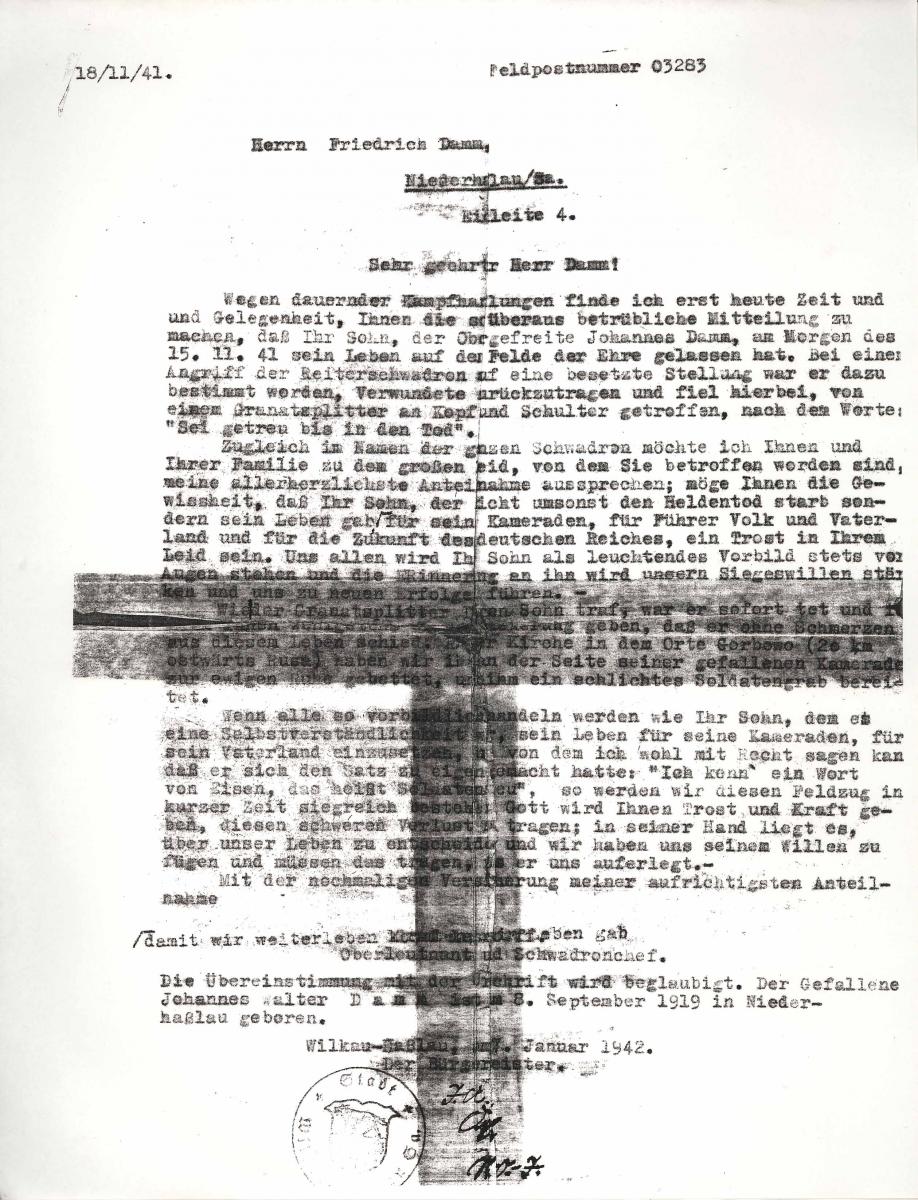 The commander of Johannes Damm’s unit wrote this sad letter announcing the death of the young soldier in November 1941. The dark lines are the residue of cellophane tape. (M. Damm)
The commander of Johannes Damm’s unit wrote this sad letter announcing the death of the young soldier in November 1941. The dark lines are the residue of cellophane tape. (M. Damm)
The rationing of food was a part of daily life there as well, but Jutta did not recall much deprivation until the war was over. With such a large family, Rose Damm had a challenge to keep food on the table. Once in a while, she came up short with the ration coupons and had to depend on such people as the local baker to extend her credit.
A very rare incident occurred in the Damm home in the last year of the war. This version of the story was offered by Fred Damm:
One time, an American POW went by our house and asked my mother for some water. She took him into the kitchen, and while she was getting water for him, he saw our Buch Mormon on the kitchen table and said, “I’m a Mormon!” He couldn’t speak German, but he got the message across. The family did not see him again.
As air raids over Zwickau became more severe, Manfred had a grisly assignment. Bombs had missed their probable target and hit the Zwickau Cemetery. Manfred and his Hitler Youth comrades were required to help clean up the mess. They dug around amid the rubble. “When we found a dead person, we had to raise our hand. Then the old people (too old for the military) came around and took the dead people out. We were not supposed to touch the bodies. We did that in Wilkau too.”
Toward the end of the war, the National Socialist propaganda machine promised the German people Wunderwaffen (miracle weapons) that would destroy the enemy and preserve the victory for Germany. Manfred recalled hearing about those Wunderwaffen and claimed, “Nobody believed it anymore.” While German troops were retreating on nearly all fronts, conditions worsened on the home front. Interruptions in utility services made life more challenging. For example, Manfred told of using candles on the sacrament table during evening meetings: “In the wintertime, it was dark during sacrament meetings. We had to use candles to read the sacrament prayers.”[5].
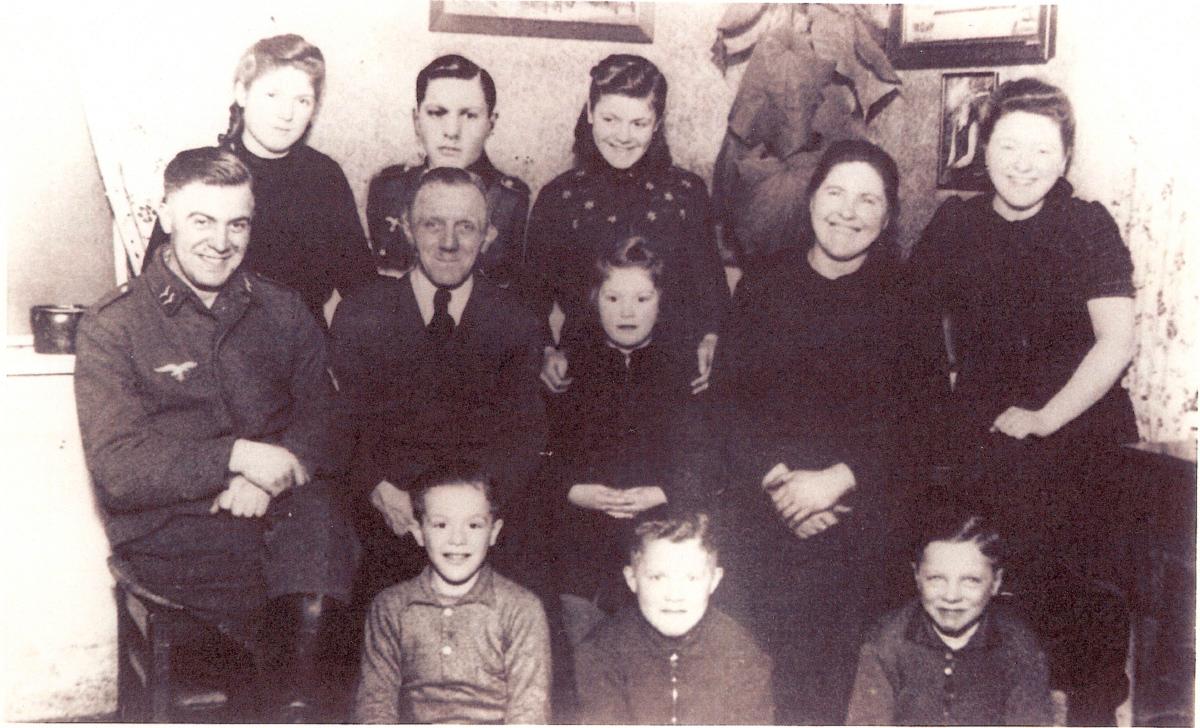 The Damm family of Wilkau-Hasslau in about 1942. Johannes (back row in uniform) had already died in battle, but his picture was inserted into this photograph to complete the family group. (M. Damm)
The Damm family of Wilkau-Hasslau in about 1942. Johannes (back row in uniform) had already died in battle, but his picture was inserted into this photograph to complete the family group. (M. Damm)
The American army entered Wilkau-Hasslau in April 1945. The soldiers stayed in the area until July and then withdrew in accordance with the borders established by the victorious powers. Manfred later explained the reactions of the locals:
When the Russians came in, the difference [from the Americans] was like night and day. They didn’t look at us. They had nothing to eat. They started raping the women. . . . When we had Mutual, we didn’t let the girls go [home] alone. There always had to be a couple of boys with them.
Regarding his experience as a young Latter-day Saint in Germany during World War II, Manfred said simply, “You had to be very strong [in the faith] in Germany.”
In Memoriam
The following member of the Wilkau-Hasslau Branch did not survive World War II:
Johannes Walter Damm b. Niederhasslau, Zwickau, Sachsen 8 Sep 1919; son of Friedrich Albin Damm and Rosa Alma Morgenroth; bp. 3 Dec 1927; lance corporal; k. in battle Weljkino, Russia 15 Nov 1941 (F. Damm; Sonntagsgruss, no. 2, 18 Jan 1942, 8; www.volksbund.de; IGI; PRF)
Notes
[1] Presiding Bishopric, “Financial, Statistical, and Historical Reports of Wards, Stakes, and Missions, 1884–1955,” CR 4 12, 257.
[2] Jutta Damm Sedlacek, interview by the author in German, Wilkau-Hasslau, Germany, June 4, 2007; summarized in English by Judith Sartowski.
[3] Fred Damm, interview by the author, Bountiful, Utah, April 18, 2006; unless otherwise noted, audio version or transcript of the interview in the author’s collection.
[4] Manfred Damm, interview by Michael Corley, Spanish Fork, Utah, February 15, 2008.
[5] After arriving in the United States, Manfred heard Church members telling about the Saints in Germany using candles on the sacrament tables as if it were a deviation from proper procedure, even comparing the German Saints to Catholics in that regard. “This had nothing to do with Catholic practices!” Manfred insisted.
